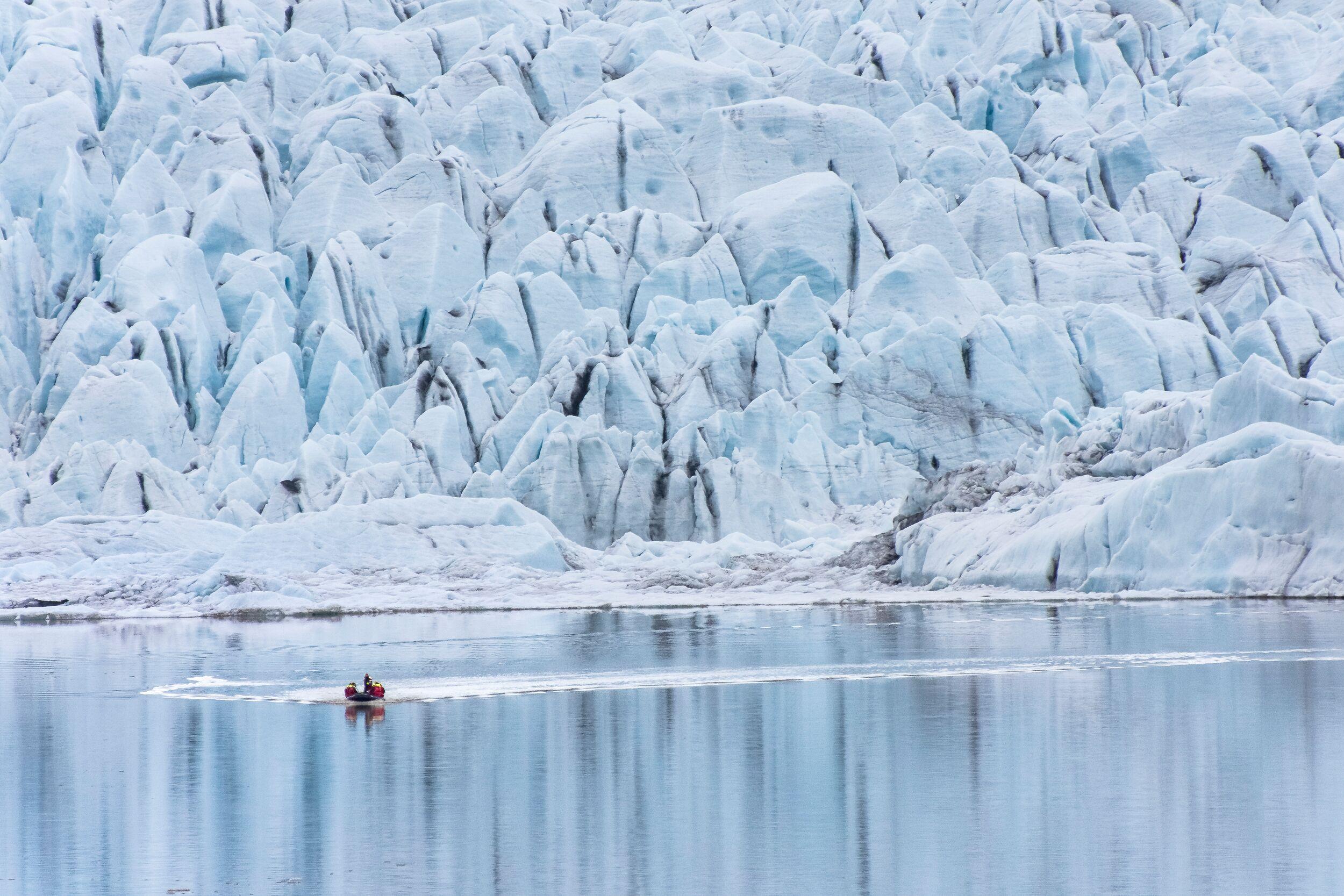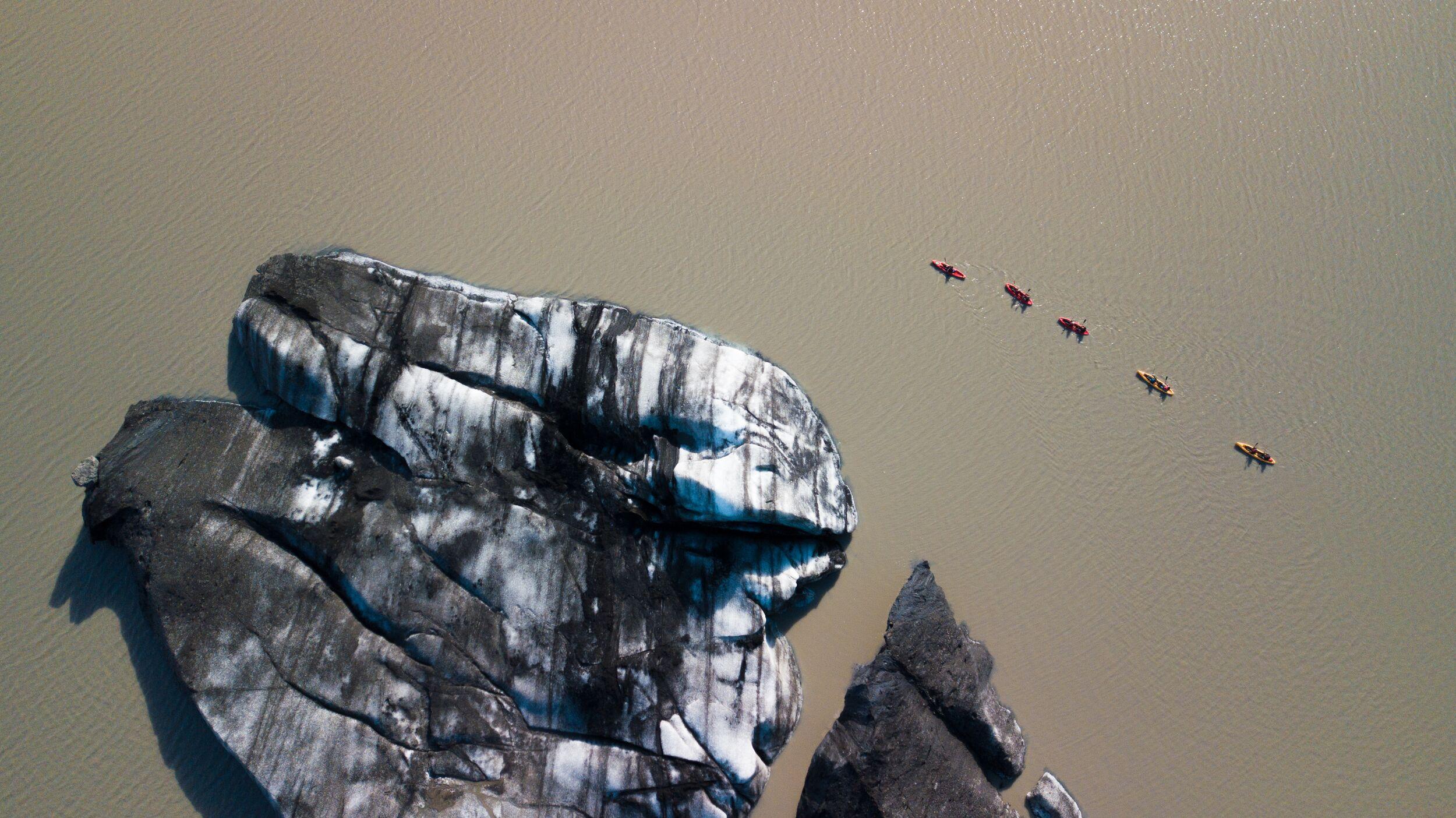
- Best time to visit
- All year-round
- Coordinates
- 64.01949, -16.38514
- Distance from Reykjavík
- 368km (228mi)
Fjallsárlón Glacier Lagoon
Fed by Fjallsjökull Glacier, the lagoon is an outlet glacier of the immense Vatnajökull Glacier, the largest ice cap in Europe. As the glacier slowly recedes, meltwater flows down towards the lagoon, creating a picturesque body of water surrounded by towering ice formations and stunning scenery. Watching the enormous chunks of ice bobbing in the lagoon is breathtaking, seeing their various hues, textures and shapes.
What sets Fjallsárlón apart from its neighbouring Jökulsárlón Glacier Lagoon is its smaller size and lesser-known status, making it a quieter and more intimate experience for visitors. Some might say it’s a hidden gem in the southeast of Iceland. The lagoon spans approximately 2 kilometres (1.2 miles) in length and provides an opportunity to witness the natural beauty of Iceland’s glaciers up close and personal.
The lagoon also offers fantastic opportunities for photography, as the ever-changing ice formations and reflections in the water provide a captivating subject. However, you don’t need to be a professional photographer to capture the beauty of the lagoon. A trip to Fjallsárlón gives visitors a chance to bask in the serene beauty of the lagoon, the surrounding mountains, and the glacier, creating memorable images.
Fjallsárlón Glacier Lagoon tours
Visitors to Fjallsárlón Glacier Lagoon can take boat tours to explore the lagoon and get closer to the floating icebergs. These tours offer a unique perspective on the glacier and its icy surroundings. The striking blue colour of the icebergs contrasting against the dark waters of the lagoon creates a mesmerising sight.
Fjallsárlón Glacier Lagoon tours in Iceland offer a unique and immersive experience in the country’s stunning natural landscapes. The lagoon is surrounded by vast glaciers and towering mountains, creating a dramatic and picturesque, classically Icelandic setting. The crystal-clear glacial water reflects the surrounding scenery, making it a photographer’s paradise.
These boat tours usually involve a small boat or zodiac and venturing out onto the lagoon with a trained guide. The boat will take you close to the glacier, allowing you to marvel at its stunning ice formations, deep crevasses, and vivid blue colours. The experience of sailing amidst the floating icebergs is awe-inspiring. If you’re lucky, you might see a seal bobbing in the lagoon or some seabirds landing on the shore.
Are Fjallsárlón Glacier tours worth it?
The trained tour guides are knowledgeable about the region’s geology, glaciology, and history. They provide valuable insights into the formation and characteristics of the glacier, as well as the surrounding environment. Tours give you a chance to learn about the effects of global warming on glaciers and the importance of preserving these natural wonders. Climate change is wreaking havoc on glaciers across the world.
How long do Glacier Lagoon tours last?
Fjallsárlón Glacier Lagoon tours typically last for a few hours, including transportation to and from the lagoon. They are usually offered as part of a guided tour package, including visits to nearby attractions such as Jökulsárlón Glacier Lagoon or Skaftafell Nature Reserve. It is also possible to meet on-site and take a boat tour of the glacier lagoon.
Does the glacier calve into the lagoon?
Fjallsárlón is known for its large icebergs breaking off the nearby glacier and floating in the lagoon. During the boat tour, you’ll have the opportunity to get up close to these icebergs and witness their intricate shapes and textures. It’s a truly incredible sight, and you might even see icebergs flip over, exposing new ice to the air.
How to dress when visiting Fjallsárlón Glacier Lagoon
It’s crucial to dress appropriately with layers of warm clothing as the weather near the glacier can be cold and windy, even during the summer months. Additionally, always follow the instructions of your tour guide and signs in the area to ensure your safety and to help preserve the fragile environment.
Safety information
Never attempt to walk on a glacier without a trained glacier guide, as there can be sinkholes and crevasses. Falling into a sinkhole can result in serious injury. There are glacier walking tours you can sign up for to experience the beauty and vastness of a glacier. At Fjallsárlón Glacier Lagoon, do not enter the water at any time.
Where Fjallsárlón Glacier Lagoon is located
Fjallsárlón Glacier Lagoon is located along the Ring Road, making it easily accessible for travellers exploring the southeastern region of Iceland. It is a must-visit destination for nature lovers, photographers, and anyone seeking a peaceful and awe-inspiring experience amidst Iceland’s glacial landscapes.
Please note that if you are self-driving to the area, it’s always a good idea to check for the latest updates on road and weather conditions before planning a trip to Fjallsárlón Glacier Lagoon. The most convenient and safest option is signing up for a tour that visits the lagoon.
FAQ
Fjallsárlón Glacier Lagoon is worth visiting any time of year. In the summer, there are longer days of sunlight (around 24 hours of daylight on the summer solstice) and milder temperatures. Also, in the summer, the surrounding area outside the lagoon has lush green colours. However, in the winter, you have the soft light of the season and the chance to see northern lights at night.
Fjallsárlón is a safe area to visit in Iceland. Some tours visit the site, and it is possible to take boat tours on the lagoon. Always listen to your tour guide for safety information and pay attention to signs in the area.
Tour companies stop by Fjallsárlón Glacier Lagoon on tours to southeast Iceland. It is also possible to self-drive to the area, but tours afford you the comfort and convenience of exploring Iceland and leaving the driving to the experts.
Fjallsjökull covers an area of approximately 30 square kilometres (11.6 square miles). Like other glaciers in Iceland, it is formed by compacted snow that has accumulated over time. Fjallsjökull has typical Icelandic glacial features such as crevasses, icefalls, and unique ice formations.
Jökulsárlón Glacier Lagoon is one the most popular tourist attractions in southeast Iceland. It is located on the edge of Vatnajökull National Park and is close to Fjallsárlón Glacier Lagoon.
Jökulsárlón Glacier Lagoon was formed somewhat recently, in the mid-1930s, as a result of the receding of Breiðamerkurjökull, an outlet glacier of Vatnajökull. As the glacier receded, it left behind a large, deep lake filled with meltwater.
Much larger than Fjallsárlón, Jökulsárlón is renowned for its stunning icebergs, which calve from the nearby Breiðamerkurjökull glacier. These massive icebergs break off from the glacier and float in the lagoon. Jökulsárlón Glacier Lagoon covers an area of about 18 square kilometres (7 square miles). Furthermore, Iceland’s deepest lake has depths reaching around 248 meters (814 feet).
Icelandic glaciers have been receding at an accelerated rate in recent decades due to rising global temperatures. Glaciers experience enhanced melting as temperatures increase, leading to a loss of mass. This retreat is evident in the decreasing size and thickness of glaciers throughout the island, including famous glaciers like Vatnajökull and Langjökull.
Iceland’s reduced mass of glaciers has resulted in a substantial loss of ice volume. This impacts Iceland’s environment as the glaciers melt and shrink; they contribute less to the overall freshwater supply of rivers and streams fed by glacial meltwater. In the long run, this can have implications for water availability and ecosystems that depend on glacial runoff.
While glacial retreat alters the landscape and has a dire impact on the environment, melting glaciers also affect Icelandic tourism. Indeed, Iceland’s glaciers are known for their famous ice caves and unique ice formations. However, with the retreat of glaciers, ice caves are becoming increasingly unstable and may even disappear altogether. The loss of these natural ice formations will impact tourism and their cultural significance.
Fjallsjökull is a part of the Vatnajökull ice cap, which is the largest ice cap in Europe, covering an area of around 8,100 square kilometres (3,130 square miles). The mighty Vatnajökull and its outlet glaciers, including Fjallsjökull, contribute to the sweeping landscapes and unique beauty of the region.
Iceland’s glaciers support diverse ecosystems, and as glaciers recede, the habitats that depend on cold, glacial environments, including particular plants, animals, and microorganisms, are negatively affected. Additionally, glacial runoff and sediment input changes can influence downstream ecosystems and aquatic organisms.
Also, glacial meltwater from Icelandic glaciers contributes to rising sea levels globally. While Iceland’s glaciers alone do not significantly impact sea level rise, their contribution is part of a broader global trend of melting glaciers and ice caps.
Fjallsárlón and Jökulsárlón are not only visually captivating, but they also serve as a habitat for various wildlife species in Iceland. For instance, seals are commonly seen in the lagoons, especially during the summer months. Bird enthusiasts can spot a variety of seabirds, including Arctic terns and skuas, which nest in the surrounding area.
Due to its unique icy beauty, Jökulsárlón Glacier Lagoon has been featured in several films, including James Bond’s “Die Another Day” and Christopher Nolan’s “Interstellar.” Its picturesque scenery and unique ice formations make it a popular choice for filmmakers.
Related tours

Blue Ice Experience and Fjallsárlón Iceberg Lagoon
Take your Iceland self-drive adventure to the next level with this combo tour on a beautiful outlet glacier and a boat ride along a stunning lagoon. Experience the beauty of Iceland’s mighty glaciers on foot and in water. Expect an easy tour with a 3.5-hour guided glacier hike and a 1.5-hour scenic boat ride on the Fjallsárlón Glacier Lagoon.

South Coast & Glacier Kayaking
Discover the essence of Iceland's natural beauty on this day tour, featuring two of Iceland's most renowned waterfalls and an exhilarating kayaking experience on a glacier lagoon. Journey through landscapes that blend cascading waters with icy wonders, all in a single, unforgettable day.

